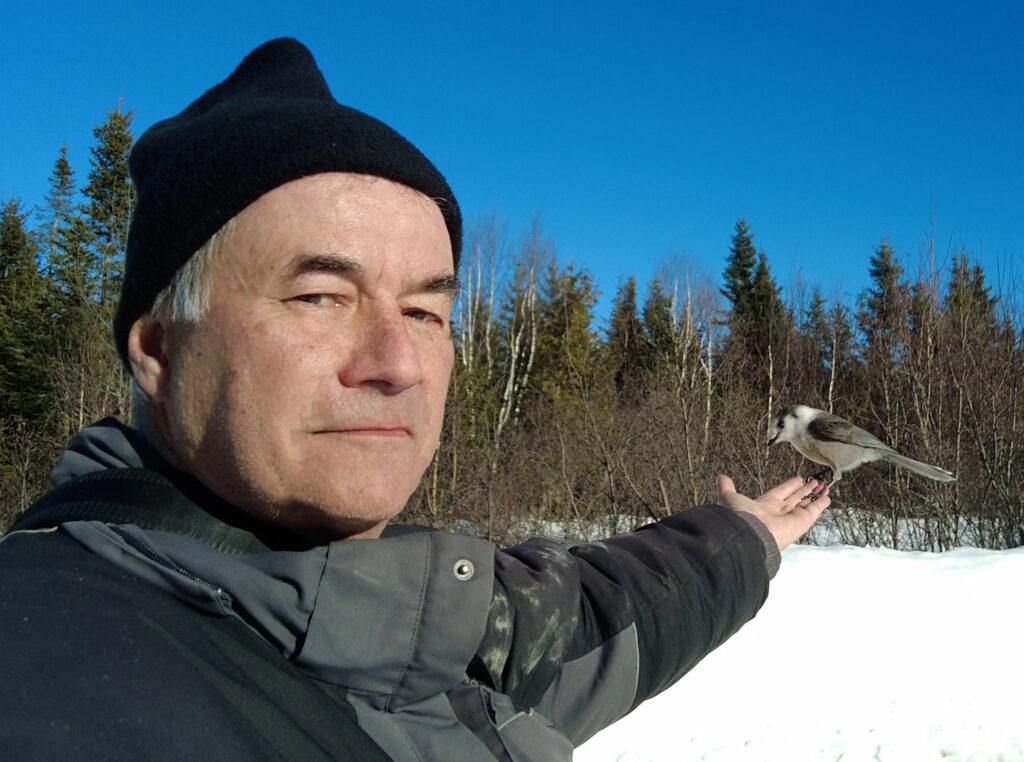
You can find these entertaining birds in the North Maine Woods
By Bob Duchesne
Canada jays are smart enough to go to college, except that they never leave the northern forest. They are among the most entertaining of Maine birds.
I’m overdue for a trip into the North Maine Woods. I keep waiting for winter to arrive, and I’ve only used my snowblower once all season.
A good snowpack in the woods often convinces northern forest birds to approach plowed roads, where they can be seen more readily. They forage for food blown onto the road, and grit to aid digestion.
The hardpack coating of snow often makes gravel logging roads smoother to drive in the winter, compared to the wash-boarded roads of summer. You’re less likely to puncture a tire on sharp shale. Just stay out of the way of logging trucks, and the winter woods can be quite a pleasant adventure.

CANADA JAYS — Bob Duchesne demonstrates how friendly Canada Jays are. The birds learn quickly that people can be a source of food.
When it comes to Canada jays, you don’t have to find them. They find you. While many birds view humans with suspicion, Canada jays see us as an opportunity. They deserve their nickname of “camp robbers,” coming right down to the picnic table to boldly snatch a morsel.
But there’s more to it than that. I’ve spent a lot of one-on-one time with them, and there are a few things you should know.
Canada jays aren’t automatically drawn to people and the food we might offer. It’s learned behavior. When I encounter them in wilderness areas, they show curiosity, but no interest in what I might have to offer.
But once they figure it out, they have no shame. Wherever there is a well-used campsite or a place where snowmobilers park their trailers, you’ll find jays waiting. I’ve met some jays that recognize the sound of a vehicle approaching. They’re calling in the treetops before I even park.
Camp robbers seem to understand our mealtime schedules, too. At Sand Bank Campground in Katahdin Woods and Waters National Monument, they appear each morning right at breakfast, then don’t return until lunch.
I recall another morning at a campsite along Telos Road, heading toward Chamberlain Lake. The jays were so accustomed to the breakfast schedule that one was waiting for me to step out of the outhouse. He was on a low branch, eye-to-eye, three feet away, with an expression that said, “C’mon, I’m waiting.”
I usually encounter Canada jays in pairs or family groups of four, occasionally five. In popular camping areas, they will come in and take food out of your hand.
If they’re less accustomed to people, one is likely to be bolder than the others, swooping in to accept whatever food you’re offering. The others watch and learn. It seldom takes long for them all to drum up enough courage.
There is a certain rhythm to their annual behavior. Canada jays are ordinarily vocal. They are relatively large and slow, making them ideal prey. They compensate by being extra vigilant and communicating with each other.
But they go mostly silent during breeding season, lest they call attention to their nest. Even after the youngsters fledge, the parents stay relatively quiet, protecting their unwary offspring, which are eager for food and attention. They may start vocalizing even when their parents would rather they wouldn’t.
In late spring, when their fledglings are most vulnerable, the family is especially watchful. I catch them sneaking in for a peek at me, just to make sure I’m not dangerous. Then they quietly glide away.
Adult Canada jays are gray with a white forehead, belly and throat. Immature birds are dark gray overall. Since they are just as curious about humans as the adults are, it’s easy to spot the youngsters and know that a family is present.
Thus, we know with great certainty where they breed. During the Maine Bird Atlas conducted from 2018 to 2022, species were mapped statewide. Since Canada jays are found only in the spruce-fir forests of the north, and don’t migrate, their range was easily established.
Predictably, they inhabit boreal patches in our vast northern forests, starting around Lincoln.
Their range extends farther south along both edges of the state, following the western mountains south to Bethel, and the coastal maritime forest down to Jonesport.
Their coastal range extends westward as far as Sunkhaze Meadows National Wildlife Refuge in Milford.
Maybe that’s changing, though. I’m getting a little worried about my local Canada jays. I don’t see them as often as I used to. Or maybe they’ve just gotten bored with me, saying, “Oh, it’s just Bob again.”